Top 10 Worst Parts of the Great Potato Famine of Ireland
Okay, given most of my lists in 2022, thus far, have taken on a history theme, and given I am of Irish descent, I was kind of wondering how well I would fare in making a list about a nation other than the United States. I will admit that it was a struggle, in contrast with my lists about the United States, but here is my first list that focuses on a nation other than the United States of America.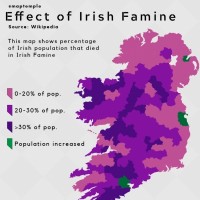
When the famine ended in 1852, about one million people in Ireland died of starvation, disease, or in many cases, both. That was roughly one eighth of the population of Ireland. Once 1855 came around, about two million people had left Ireland. The ships that they fled the Emerald Island in were very crowded and they were kept in rather poor shape. These ships got dubbed as "coffin ships," as they caused even more deaths of the Irish people trying to leave their country. In present day, 150 years after the famine, Ireland's population still has not completely recovered from the damage done by the great potato famine.

Once 19th century rolled around, potatoes were a probably the most important crop in Ireland, and they kept the poor healthy. Most of the working class had rather small areas of "tenant farms" and the potato was the only crop that could provide enough nutrients and quantity when grown in such a small space.
In 1844, reports were released that a disease was essentially poisoning potatoes on the east coast of America. The year after, the same disease surfaced in Ireland, hitting the Emerald Island with devastating harm. The first year Ireland had this disease in their potatoes, between one third and one half of the crop was lost because these potatoes were diseased, and by 1846, the amount of diseased potatoes mounted up to three out of four.
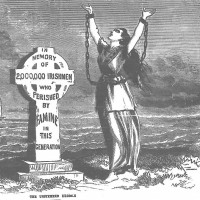
Those in the British government viewed the Great Potato Famine as an act of God, much like those in the Old Testament, and they figured it was meant to punish the Ireland and decimate Irish agriculture, which was heavily dependent on potatoes.
The man responsible for trying to help Ireland rebound from their famine, believed that it was God's way of punishing the Irish people. And with the result of this theory, lots of Irish people believed that they were simply left to die in Ireland, and that the British wanted it that way. So they jumped to the conclusion that the situation should be treated like a massacre, as opposed to a period of starvation.

Great Britain's Prime Minister, at the time, this guy named "Sir Robert Peel" did attempt to provide relief to the Irish during the Great Potato Famine, and at first, things seemed to get better. But when Lord John Russell rose to power in Great Britain, in June of 1846 the focus went from helping Ireland to Great Britain becoming more dependent on Irish resources and Irish market. Britain was back then, what the USA is to the world in present day. The world's richest nation and the nation you'd ask for help from in a tough situation. After 1847 there was enough food to prevent starvation. But as the history books say unproductive governance and faulty handling by Britain made things worse than they already were and the famine continued in Ireland until 1852.
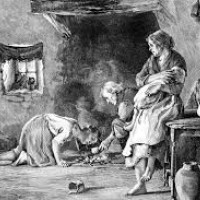
The 1800s were not a century worth bragging about real estate. Tenants were not what they are today. They followed the guidelines in place by landlords, and the landlords used laws that were unfair to those tending the land to their advantage. The balance between Great Britain's enabling, landlords, and tenants was a weak balance, if you could indeed call it balance. This made tenants living in poverty incapable of affording the cost of living, better known as rent. While families lived poor lives beyond anything I can understand, Ireland's population was at its all time high, at the start of the famine, which meant there were very few options for those trying to get out of the rut, and make a living for their families and themselves. With landlords requiring more from tenants, the cycle was inhumane and hard to escape.

In the 1800s, Ireland was still under the influence of Britain. Thus when the famine struck, the Irish came to the British government for help. The Whig government of Great Britain worked with laissez-faire economics, claiming that the market would provide the food that Ireland needed immensely. Food and works programmes started by the Tory government were stopped, but food exports to Great Britain never stopped and the Corn Laws were kept in place. As you would expect, the famine in Ireland got much worse. Thousands of Irish people no longer had ways to work, feed their families, or make money.
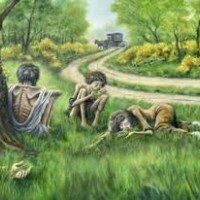
With potatoes crops devastated by blight, many Irish found themselves lacking the resources needed to feed themselves and their families. Potatoes, usually a bountiful crop, were a food staple for the Irish in poverty, and exporting potatoes to England gave farmers with a primary source of income. Unable to support themselves during the famine, lots of Irish people found that they couldn't buy any food whatsoever, and were often pushed to becoming dependent on their surroundings for survival. Many have claimed that the Irish did indeed eat grass during the famine, and they died with green stains around their mouths that suggested they were desperate enough to start eating grass. Historians have also made the claim that this is why lots of Americans eat green foods on Saint Patrick's Day. There are plenty of historians who claim that eating grass during the famine is simply a misconception. Whether you believe this or not, yourself, it makes sense that given the dire circumstances, the Irish ate things like leaves, bark, and grass, to survive.
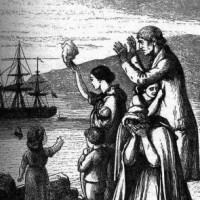
I was actually kind of reluctant to add this one to the list, at first, since as a guy who lives in the United States, I viewed this as a good thing, but towards the end of my research, I started to view this in the lens of the Irish. Anyway, Hordes of Irishmen left the Emerald Island during the famine, to escape it. About 90% moved to the United States or Canada, roughly 70% moved to states in the northeastern part of the United States. To be specific, they moved to either New York, Connecticut, New Jersey, Pennsylvania, Ohio, Illinois, or Massachusetts.
Getting into the United States or Canada was still a struggle to do successfully, and a dangerous endeavor, but for those leaving Ireland, there really wasn't a better alternative. It was die in the famine, or leave Ireland. Sometimes, landlords would pay for the passages for their tenants travel, which actually was viewed similarly to paying for the tenants' funerals.

Very few, to no cases of crops being infected even come close to match the devastation that the late blight in potatoes did in the 1840s. Late blight is a crop disease caused by these things called "Phytophthora infestans," which traveled from Mexico and the United States to Europe in the 1800s, and these infestans led to the Great Potato Famine in Ireland. Phytophthora, late blight, or whatever you refer to it as, is very potent. If someone smelled an infected potato, that alone would be enough to make that person vomit. If someone were to eat that potato, that would make the individual extremely ill. Unfortunately, I think we simply as that both happened a later, during the potato famine. Especially in the early parts of it, as the Irish didn't know better.
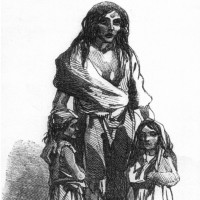
Given there was a huge economic impact of the Great Potato Famine, the Irish had not much money to spare, and with the little amount of money they had, there was the big question: should they pay their respects to the deceased, or make sure the living stay alive. Most Irishmen choose keeping their families healthy and alive over the proper funeral, although I'm sure there were a few who chose to have funerals. Not saying much, though.

Okay, this needs some clarification. Many people jump to the conclusion that all Irish emigrants got in coffin ships from their homeland to migrate to Canada and the United States of America, were coffin ships. The term 'coffin ship' was a term reserved vessels that were not very promising vessels and or they were disease spreading in the confinements of the ship.
The coffin ships were disease infected, and let me tell you that that indeed made living on the vessel easy, and people would get some of that disease, and for most of the part, they would die on the way to North America.
And if it wasn't for disease, there was being malnourished, dehydration or they could possibly die in a shipwrecks, or even more food poisoning. The coffin ships symbolized how far the Irish people would go, and how low they would stoop to escape the famine, get some food, or both.
Whether they were driven by survival of the fittest, greed or ignorance, or simply economics, the Irish would do whatever they had to, if it meant even just coming closer to getting better lives, and better food.

Some have said that Ireland was exporting enough to feed all of its citizens, whilst others claim it was exporting less than 10% of pre-famine quantities, and imports of grain greatly outnumbered exports.